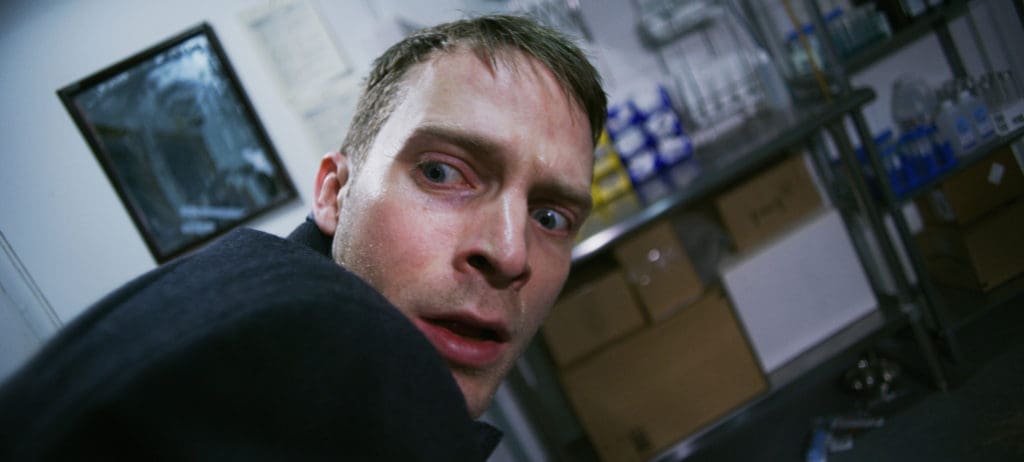There have been dozens, maybe hundreds, of adaptations of Mary Shelley’s 1818 novel, Frankenstein. The latest, Depraved, premiered last night at New York’s What the Fest!? Written, directed, edited and produced by filmmaker Larry Fessenden (likely best known for his acting work in small-budget horror films), it somehow manages to take the familiar story and make it feel new.
Mainly, Fessenden does that by making the “monster,” not his makers, our protagonist. The film starts in modern day Brooklyn with Alex (Owen Campbell), a commitment-phobe who throws a tantrum when his longtime girlfriend, Lucy (Chloe Levine), obliquely mentions children. He’s a bit of a bore and the prospect of spending more time with him isn’t terribly enticing. Thankfully, he’s quickly murdered by a mysterious figure only to wake up in a new body the next day. That body is “Adam” (Alex Breaux), the freakish medical creation of a traumatized Iraq War vet, Henry (David Call). Unfortunately, though the doctor has managed to bring Adam to life, Alex’s brain has been damaged in the process and we spend the film’s first act watching him achieve adult-level consciousness again.
Though that learning process could easily become tedious, Fessenden manages to make it interesting both intellectually and visually. As Henry explains to Adam, though his brain may not be able to restore the broken connections caused by the trauma it’s experienced, it can create new pathways. While Adam listens to classical music or completes various puzzles, Fessenden uses James Siewert’s visual effects and animation to rather cleverly convey those regrowing pathways with a sort of light-show overlay special effect. In bright colors, we see synapses grow and expand as Adam learns. Fessenden uses the same technique throughout, but one of the most striking is the sort of synesthesia effect created when Fessenden uses blooming colors and kaleidoscopic shapes to emphasize Adam’s emotions in any given moment.
That said, those moments perhaps wouldn’t work if Breaux didn’t perform them so well. Rather than reduce Adam in those early scenes to some bumbling dunce, Breux makes him seem both childlike and unnervingly sophisticated. His brain is, after all, an adult’s, just uniquely damaged. So, those blooming colors don’t just seem like an effect, we buy that Adam may actually see them because of the way his brain is rewriting its pathways. Even more impressive is Breaux’s physical performance—which is subtly and skillfully aided by Gerner and Spears’s make-up effects and creature design. Not only do Adam’s shambling gait and stiff movements emphasize that Adam was recently dead, but his seeming unfamiliarity with his limbs suggests the disturbing sense of body dysmorphia he’d likely feel after suddenly waking in a new body.
However, while Breaux is the film’s most impressive performance, the rest of the cast is pretty good too. Call is clearly suffering as Henry and while the character’s behavior can sometimes seem erratic, we hear enough about his PTSD to mostly accept it. Most of that helpful–and occasionally clunky–exposition comes from Ana Kayne as Henry’s ex-girlfriend, Liz, a therapist who works with veterans and takes pity on Adam. Admittedly, as much as Kayne commits to her role, there are moments when she can’t quite sell her relationship with Adam. Particularly notable is a scene where she walks in on him naked and not only doesn’t ask him to cover up, but allows Adam to caress her. It’s a compelling moment to be sure, but Liz knows Adam is a living corpse and should be more repulsed even if her and Henry are on the rocks.
The worst offender of all, though, is Joshua Leonard’s John Polidori (a reference to the writer of The Vampyre, which arguably started he vampire genre), the mysterious benefactor behind Henry’s research. He’s an overconfident douche who can’t wait to profit off of Henry’s achievement and Leonard plays him that way—almost to the point of camp. Perhaps the film’s chunkiest scene comes when Polidori brings Adam to The Met. As they view various pieces, Polidori goes on and on about human nature and while the moment is meant as foreshadowing for the turns the film will take later, it’s also too obvious in laying out Fessenden’s central thesis. It’s a disappointingly inelegant sequence in a film that’s otherwise pretty sophisticated.
Still, regardless of that scene’s weaknesses, when the film delivers on its promises in the final act, Fessenden really dials up the horror. It’s difficult to say exactly how without spoiling everything, but suffice to say Depraved manages to deliver an ending that’s scary, disturbing and emotionally satisfying. Fessenden maybe hasn’t made a perfect film, but it’s genuinely great horror.


